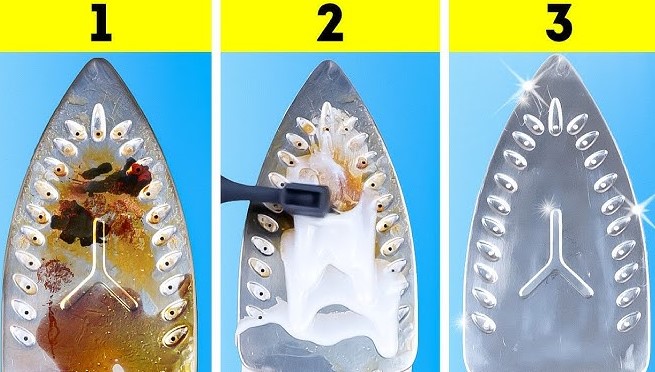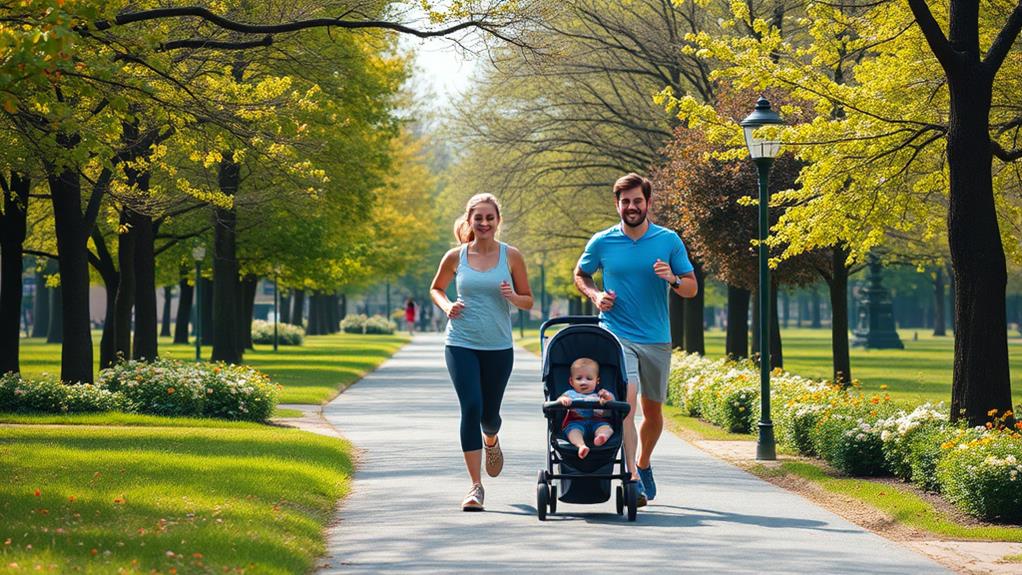After dinner, you might find that a gentle stretch can be just what you need to unwind and prepare for a good night’s sleep. By incorporating specific yoga poses into your evening routine, you can calm your mind and ease any discomfort from the day’s meals. Waiting a couple of hours post-meal allows your body to settle before you begin. But which poses are most effective for enhancing relaxation and promoting better sleep? Understanding the right techniques could transform your nighttime ritual and lead to more restorative rest.
Key Takeaways
- Practicing yoga 1-2 hours after dinner enhances digestion and reduces bloating for a more comfortable night’s sleep.
- Gentle poses like Child’s Pose and Seated Forward Bend calm the mind, promoting relaxation and stress reduction before bed.
- Legs-Up-The-Wall Pose is restorative, encouraging deep breathing and preparing the body for restful sleep.
- Incorporating Supine Spinal Twists helps release back tension and improves spinal mobility, aiding overall relaxation.
- Ending with Corpse Pose (Savasana) allows for focused breathing, enhancing the transition to sleep.
Benefits of Post Dinner Yoga
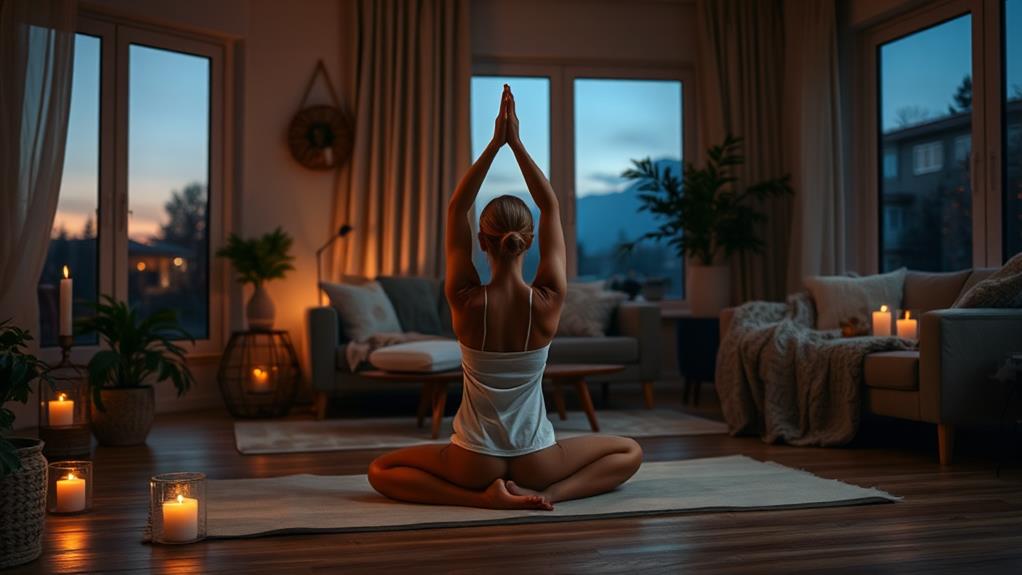
Practicing post dinner yoga regularly can greatly enhance your digestion and overall well-being.
It’s a fun way to help your body feel better after a meal. When you do yoga after eating, gentle stretches can relieve any bloating or discomfort. You’ll find that your stomach feels lighter, and that’s always nice!
Besides helping digestion, post dinner yoga can also calm your mind. After a busy day, you might feel a bit wound up. Taking just a few minutes to stretch and breathe can help you unwind.
You’ll feel more relaxed, making it easier to enjoy your evening and prepare for a good night’s sleep.
You might also notice that doing yoga before bed can improve your sleep quality. When your body is relaxed and your mind is clear, it’s easier to drift off into dreamland.
It’s a win-win!
Ideal Timing for Yoga
Finding the right time for yoga after dinner can maximize its benefits. Ideally, you should wait about 1 to 2 hours after your meal before you start your yoga practice. This gives your body enough time to digest your food, so you won’t feel uncomfortable while stretching and moving.
If you jump into yoga too soon, you might feel sluggish or even a bit queasy.
Once you’ve waited a bit, try to find a cozy, quiet spot in your home. You want to create a peaceful atmosphere, so dim the lights or light a candle if you can. This helps your mind relax and sets the mood for your practice.
Also, consider the time of day. If you usually wind down in the evening, doing yoga right after dinner can be a perfect way to signal to your body that it’s time to relax. You’ll feel more prepared for a good night’s sleep.
Gentle Yoga Poses Overview
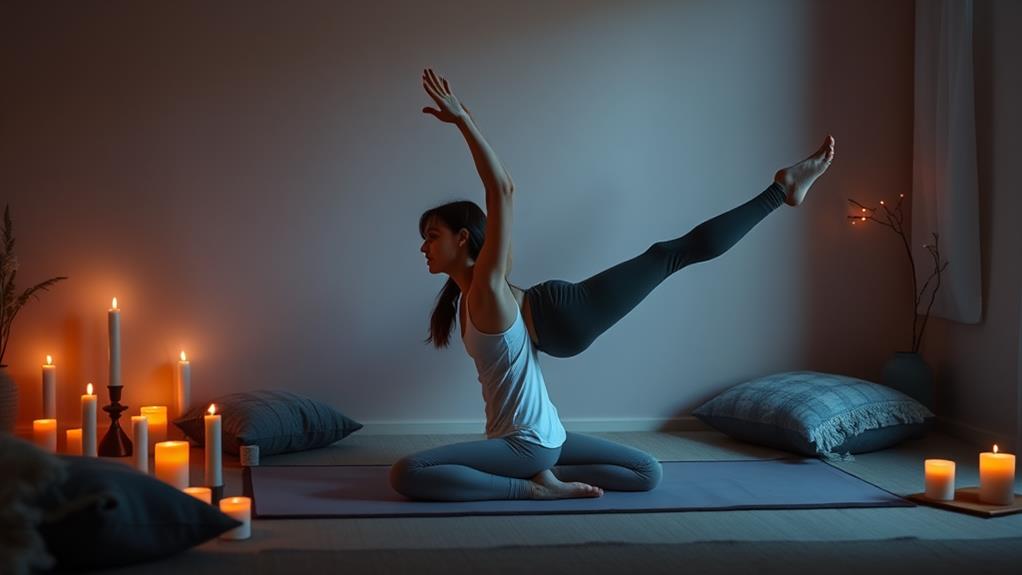
Gentle yoga poses are perfect for easing into relaxation after a satisfying meal. These soothing stretches help your body digest food while calming your mind, making it easier to drift off to sleep. You don’t need to be an expert; just find a comfortable spot and give them a try!
One great pose to start with is the seated forward fold. As you sit with your legs stretched out in front, gently lean forward, reaching for your toes. This pose helps release tension in your back and legs.
Another wonderful option is the gentle twist. Sitting cross-legged, place one hand behind you for support and twist your body to the side. This stretch feels delightful and aids digestion.
Don’t forget to focus on your breath while you practice these poses. Inhaling deeply and exhaling slowly can enhance your relaxation.
You might also enjoy a gentle side stretch, reaching one arm overhead while leaning to the opposite side. Each of these poses encourages you to unwind and relax, preparing your body for a restful night.
Child’s Pose
Child’s Pose is a fantastic way to relax after a meal, helping you unwind and feel more comfortable.
You’ll love how it gently stretches your back and hips while calming your mind.
Let’s explore the benefits of this pose and how to practice it easily at home!
Benefits of Child’s Pose
After a hearty meal, you might feel the need to ease tension in your body, and Child’s Pose is an excellent choice for this purpose. This gentle yoga pose helps stretch out your back, hips, and thighs, making it perfect for relaxation.
As you settle into Child’s Pose, you’ll notice how it calms your mind and soothes your spirit, helping you shake off any stress from the day.
One of the great benefits of Child’s Pose is that it encourages deep breathing. When you relax and focus on your breath, your body starts to unwind, promoting better digestion after your meal.
You may also find that this pose helps relieve any discomfort or bloating, allowing you to feel lighter and more at ease.
Additionally, Child’s Pose is incredibly accessible, so anyone can practice it, regardless of experience level. You don’t need to be a yoga expert to enjoy its many benefits.
Just a few moments in this calming position can leave you feeling refreshed and ready for a peaceful night’s sleep.
How to Practice
To practice Child’s Pose, start by kneeling on your mat with your big toes touching and knees about hip-width apart.
Take a deep breath in, and as you exhale, gently lower your torso down between your thighs. Your arms can stretch out in front of you, palms facing down, or you can rest them alongside your body, palms up. Feel free to relax your forehead on the mat; it’s a great way to let go of any tension.
As you settle into the pose, close your eyes and focus on your breath. Inhale deeply through your nose, allowing your belly to rise, and then exhale slowly, letting your body sink deeper into the stretch.
Stay in this position for as long as it feels comfortable—usually between 1 to 5 minutes is perfect.
If you want to deepen the stretch, you can gently sway your hips side to side. This helps release any tightness in your back.
Remember, Child’s Pose is all about relaxation, so don’t rush. Enjoy this peaceful moment.
When you’re ready to come out, press your hands into the mat and slowly rise back up. You’ve done great!
Seated Forward Bend
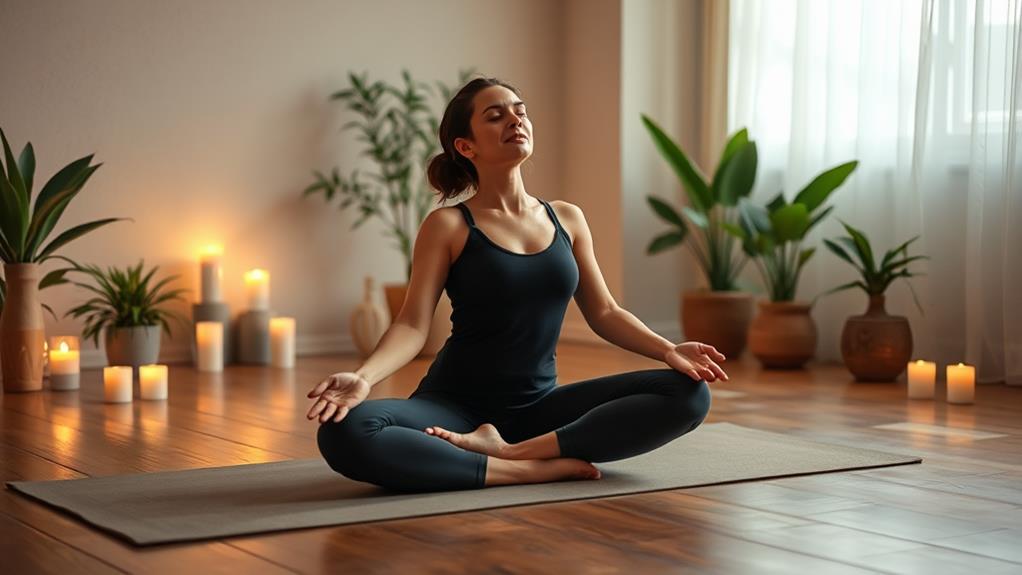
Now that you’ve enjoyed your meal, let’s explore the Seated Forward Bend!
This pose not only helps improve your flexibility but also aids in digestion, making it perfect after dinner.
We’ll cover how to get into the proper form, align your body correctly, and even share some modifications so everyone can join in!
Benefits of Seated Forward Bend
The Seated Forward Bend is a powerful pose that offers a myriad of benefits for both body and mind. When you practice this pose, you stretch your back, hamstrings, and calves, which helps relieve tension. This gentle stretch can make your body feel more relaxed, especially after a long day of sitting or moving around.
You’ll also find that this pose encourages better posture. By elongating your spine and opening your chest, you help yourself stand taller and breathe deeper. Plus, it calms your mind by promoting relaxation and reducing stress. As you fold forward, you’re not just stretching your muscles; you’re also giving your mind a break from the hustle and bustle of the day.
Another great benefit is that it can help you sleep better. By practicing the Seated Forward Bend before bedtime, you may find it easier to wind down and let go of any worries.
Proper Form and Alignment
When practicing the Seated Forward Bend, maintaining proper form and alignment is essential for maximizing its benefits and preventing injury.
Start by sitting on the floor with your legs stretched out in front of you. Keep your back straight and shoulders relaxed. It’s important to flex your feet, so your toes point toward the ceiling. This helps protect your hamstrings and lower back.
As you inhale, reach your arms overhead, lengthening your spine. Exhale, and gently lean forward from your hips, not your waist. Imagine moving your chest towards your toes rather than just reaching for them. If you can’t touch your feet, no worries! It’s all about the journey, not the destination.
Keep your neck relaxed and avoid straining; your head should follow the line of your spine. Pay attention to your alignment; your hips should stay grounded, and your knees shouldn’t bend. If you feel any discomfort, come out of the pose a little.
Hold the pose for several breaths, allowing your body to relax deeper with each exhale. Embrace the calmness this pose brings, and enjoy the peaceful moments you create!
Modifications for All Levels
Many yogis can benefit from modifications to the Seated Forward Bend, making it accessible for all levels.
If you’re new to yoga or have tight hamstrings, you can sit on a cushion or blanket. This extra height helps you reach forward more comfortably.
If you can’t touch your toes, don’t worry! You can use a strap around your feet. Just hold the strap with your hands and gently pull yourself forward. Remember, it’s about the journey, not just the destination.
For those who want more challenge, try bending your elbows and reaching for your feet while keeping your back straight. You’ll feel a nice stretch in your spine and legs.
Always listen to your body. If you feel any discomfort, back off a bit. You can also keep your knees slightly bent to relieve tension.
Engaging your breath is key! Inhale deeply as you lift your chest, and exhale as you fold forward. This encourages relaxation and helps you unwind after dinner.
With these modifications, you can enjoy the benefits of Seated Forward Bend, no matter your experience level. Happy stretching!
Supine Spinal Twist
Supine Spinal Twist is a gentle yet powerful pose that helps release tension in your back and improve spinal mobility.
To get started, lie down on your back with your arms stretched out to the sides, forming a T-shape. Bend your knees and place your feet flat on the floor.
Now, slowly drop your knees to one side while keeping your shoulders flat on the mat. You’ll feel a nice stretch in your spine and hips. Take a deep breath in, and as you exhale, let your knees sink a little further to the side. Hold this position for about 30 seconds, enjoying the gentle stretch.
Then, slowly bring your knees back to the center and switch sides. This pose not only helps relax your body but also calms your mind after a busy day.
Remember to breathe deeply throughout the pose, focusing on the release of tension with each exhale.
After practicing Supine Spinal Twist, you’ll likely feel more relaxed and ready for a good night’s sleep.
Legs-Up-The-Wall Pose
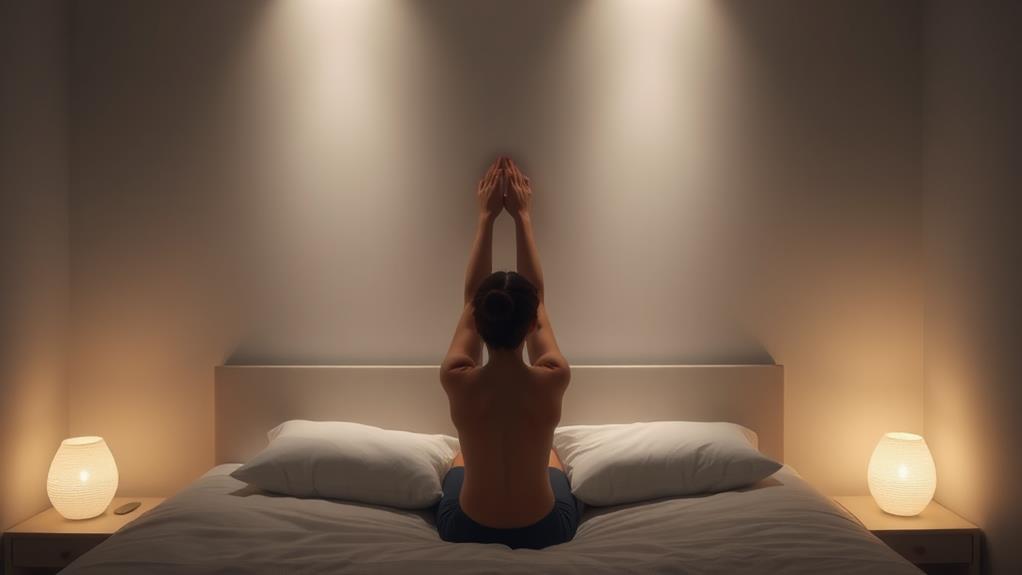
Legs-Up-The-Wall Pose, often regarded as a restorative posture, offers a perfect way to unwind after dinner. This pose is super easy to do, and you don’t need any fancy equipment. Just find a wall, sit down next to it, and gently swing your legs up while lying back. Your body will feel relaxed, and the wall will support your legs, helping to release tension.
As you settle in, try to breathe deeply. Inhale through your nose and exhale through your mouth. This rhythmic breathing helps calm your mind and body. You can stay in this pose for five to ten minutes, or even longer if you’d like! It’s a great way to improve circulation and reduce swelling in your legs after a big meal.
If you want to add a little extra comfort, you can place a pillow or blanket under your back. This makes the pose even cozier! Enjoy this peaceful moment, letting go of any worries or stress.
Once you finish, you’ll feel refreshed and ready for a good night’s sleep. So, give Legs-Up-The-Wall Pose a try tonight and enjoy the relaxing benefits!
Corpse Pose
Corpse Pose, or Savasana, is one of the simplest yet most profound postures you can practice after dinner. This pose helps you relax and unwind, making it perfect for preparing your body for a good night’s sleep.
To get started, find a quiet space where you can lie down comfortably. Spread out a yoga mat or even a soft blanket.
Lie flat on your back, letting your legs extend straight out, with your arms resting beside you, palms facing up. Close your eyes and take a moment to feel the ground beneath you. Allow your body to sink into the mat, releasing any tension from your day. You might notice your breath becoming slower and deeper.
Stay in this pose for about five to ten minutes. If your mind starts to wander, that’s okay! Just gently bring your focus back to your breath and the sensations in your body.
When you’re ready, slowly wiggle your fingers and toes, then roll onto your side. Finally, sit up comfortably, carrying that sense of calm with you as you shift into the rest of your evening. Enjoy this peaceful moment!
Breathing Techniques for Relaxation
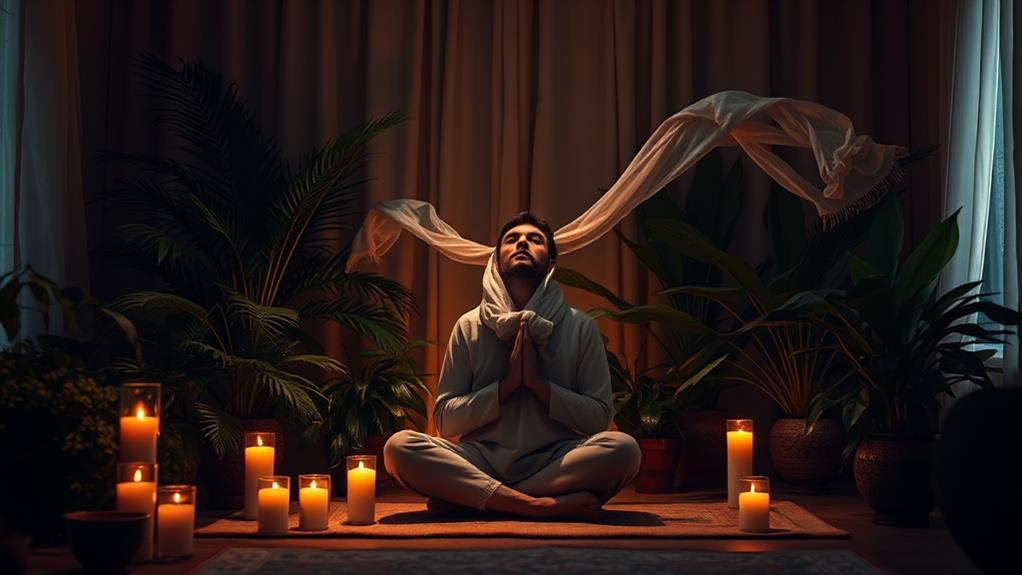
Although relaxation techniques can vary, focusing on your breath is one of the most effective ways to unwind after dinner. When you take a moment to breathe deeply, you send signals to your body that it’s time to relax.
Start by sitting comfortably or lying down. Close your eyes and take a slow, deep breath in through your nose, filling your belly. Count to four as you inhale, then hold that breath for a count of four as well.
Now, exhale gently through your mouth for a count of six. Feel the tension leaving your body with each breath out. Repeat this cycle several times, focusing on your breathing and letting go of the day’s worries.
You might find it helpful to visualize a calming scene, like a quiet beach or a gentle forest. Whenever your mind wanders, gently bring your focus back to your breath.
This simple practice can help you feel more peaceful and ready for a good night’s sleep. Remember, you’re giving yourself a gift of relaxation, so enjoy every breath!


